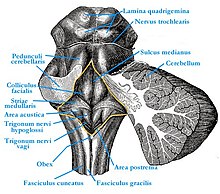Area postrema
The area postrema is a circumventricular organ at the caudal end of the floor of the rhombus fossa , dorsal to the nucleus tractus solitarii (NTS). Together with other nuclei of the reticular format , it forms the vomiting center . This functional center consists of several core groupings and is scattered far across the brain stem down to the medulla oblongata .
function
Due to the fenestrated capillary endothelium , special neurons of the chemoreceptor trigger zone in the area postrema with their numerous different receptors are located in front of the blood-brain barrier . The task of these receptors is to react as quickly as possible to toxic substances in the blood and to enable vomiting as a protective function of the organism.
Clinical significance
Antiemetics (anti-vomiting drugs) are able to block certain receptors in the area postrema. These include:
- Scopolamine (for seasickness) inhibits muscarinic acetylcholine receptors (mAChR)
- Metoclopramide inhibits the dopamine receptor D 2 and, in high doses, the serotonin receptor 5-HT 3
- 5-HT 3 antagonists specifically inhibit the serotonin receptor 5-HT 3 .
The many causes that can trigger vomiting ( dizziness , pregnancy , cytostatics , increased intracranial pressure, spoiled food, etc.) suggest a complex neural interconnection of the vomiting center and the area postrema with higher-level brain centers.
Some drugs (e.g. apomorphine ) have a relatively specific effect on the vomiting center in certain doses and can thus induce vomiting.
